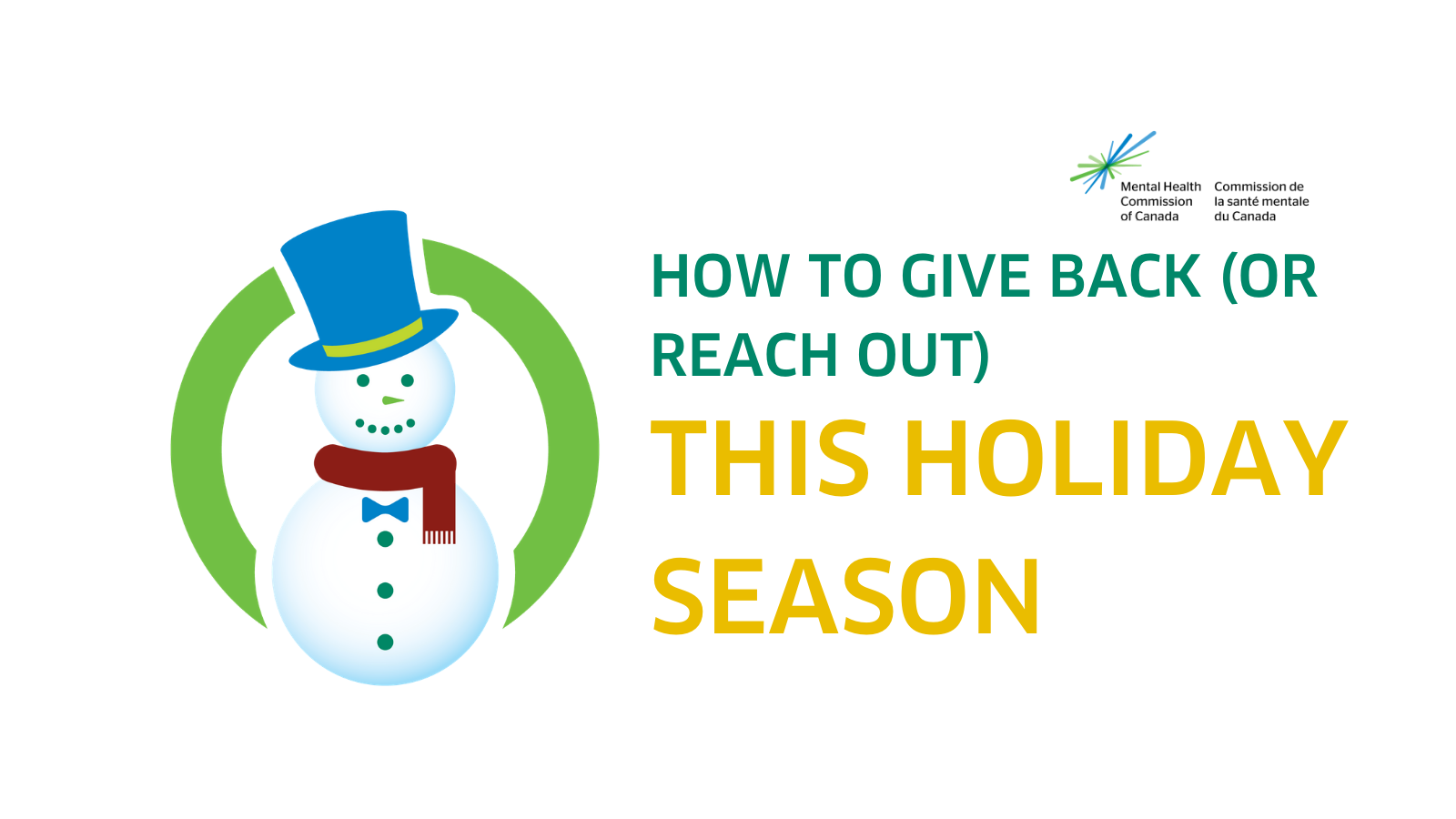If you are in distress, you can call or text 988 at any time. If it is an emergency, call 9-1-1 or go to your local emergency department.
- Public Resources, Tip Sheets
How to give back (or reach out) this holiday season
As we continue to navigate the pandemic, riding a second wave into the holidays, many of our plans and traditions are being upended. If you’ve been struggling to find your giving spirit, the following tips may help you strike the right balance between giving and receiving.
Take the time to consider what your capacity is before making commitments, regardless of what you’ve done in years past. It’s healthy to lower the bar for yourself when you need to, whether that means taking on fewer responsibilities, stepping back from some energy-depleting traditions, or saying no outright. Remember: this pandemic is a marathon, not a sprint, and recognizing your limitations will help carry you through to the finish line.
Activities like volunteering, especially when done for altruistic reasons, can be a great way to boost your mental and physical health. If your bandwidth allows you to give this season, get creative. For example, if you normally share holiday baking with family and friends, consider supporting a local bakery instead. If you want to support those who are having an especially difficult time this season, consider training as a volunteer with Kids Help Phone.
Giving back doesn’t have to involve a major time commitment or hefty price tag. Small acts of kindness can yield big results, especially at the end of a difficult year. Gestures like making an extra phone call to a relative who is isolated or picking up some groceries for an elderly neighbour can go a long way. If those things feel like too much, that’s OK, too!
There’s no shame in being on the receiving end of someone else’s kindness, even if you’re not up to giving. Just as you can’t pour from an empty cup, you can’t give to others when you’re feeling depleted. Don’t hesitate to ask for the help you need, when you need it. If you’re usually the holiday chef, for example, consider asking someone else to don the apron instead. If someone offers to take some task off your plate, don’t hesitate to accept their help. The act of generosity will benefit both of you. As we continue to navigate the pandemic, riding a second wave into the holidays, many of our plans and traditions are being upended. If you’ve been struggling to find your giving spirit, the following tips may help you strike the right balance between giving and receiving.
Clear boundaries can protect your mental wellness. Let those who may be expecting things from you know where you’re drawing the line this year. If that virtual holiday party feels like too much, politely decline. If you want to forgo certain traditions, communicate that with your family. Setting boundaries can help give you the necessary space to recharge without undue stress.
Take the pulse of your mental well-being periodically. While it’s normal to experience emotional peaks and valleys during times of uncertainty, it’s also important to check in regularly to ensure you’re getting the support you need. The Mental Health Continuum is a great self-check tool to help you gauge your mental wellness at any time. You can speak with your primary health care or mental health care provider if you are concerned about your well-being. Taking the steps to protect your mental wellness is one of the greatest gifts you can give yourself.
- Public Resources, Tip Sheets
How to give back (or reach out) this holiday season
How to give back (or reach out) this holiday season
- COVID, Self-Care
As we continue to navigate the pandemic, riding a second wave into the holidays, many of our plans and traditions are being upended. If you’ve been struggling to find your giving spirit, the following tips may help you strike the right balance between giving and receiving.
Take the time to consider what your capacity is before making commitments, regardless of what you’ve done in years past. It’s healthy to lower the bar for yourself when you need to, whether that means taking on fewer responsibilities, stepping back from some energy-depleting traditions, or saying no outright. Remember: this pandemic is a marathon, not a sprint, and recognizing your limitations will help carry you through to the finish line.
Activities like volunteering, especially when done for altruistic reasons, can be a great way to boost your mental and physical health. If your bandwidth allows you to give this season, get creative. For example, if you normally share holiday baking with family and friends, consider supporting a local bakery instead. If you want to support those who are having an especially difficult time this season, consider training as a volunteer with Kids Help Phone.
Giving back doesn’t have to involve a major time commitment or hefty price tag. Small acts of kindness can yield big results, especially at the end of a difficult year. Gestures like making an extra phone call to a relative who is isolated or picking up some groceries for an elderly neighbour can go a long way. If those things feel like too much, that’s OK, too!
There’s no shame in being on the receiving end of someone else’s kindness, even if you’re not up to giving. Just as you can’t pour from an empty cup, you can’t give to others when you’re feeling depleted. Don’t hesitate to ask for the help you need, when you need it. If you’re usually the holiday chef, for example, consider asking someone else to don the apron instead. If someone offers to take some task off your plate, don’t hesitate to accept their help. The act of generosity will benefit both of you. As we continue to navigate the pandemic, riding a second wave into the holidays, many of our plans and traditions are being upended. If you’ve been struggling to find your giving spirit, the following tips may help you strike the right balance between giving and receiving.
Clear boundaries can protect your mental wellness. Let those who may be expecting things from you know where you’re drawing the line this year. If that virtual holiday party feels like too much, politely decline. If you want to forgo certain traditions, communicate that with your family. Setting boundaries can help give you the necessary space to recharge without undue stress.
Take the pulse of your mental well-being periodically. While it’s normal to experience emotional peaks and valleys during times of uncertainty, it’s also important to check in regularly to ensure you’re getting the support you need. The Mental Health Continuum is a great self-check tool to help you gauge your mental wellness at any time. You can speak with your primary health care or mental health care provider if you are concerned about your well-being. Taking the steps to protect your mental wellness is one of the greatest gifts you can give yourself.
SHARE THIS PAGE
RELATED

Review our Assessment Framework for Mental Health Apps — a national framework containing key standards for safe, quality, and effective mental health apps in Canada.

To help expand the use of e-mental health services, we developed four online learning modules based on our Toolkit for E-Mental Health Implementation, in collaboration with the Centre for Addiction and Mental Health (CAMH).

Stepped Care 2.0© (SC2.0) is a transformative model for organizing and delivering evidence-informed mental health and substance use services.
